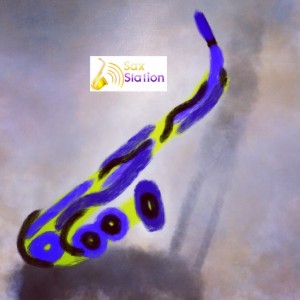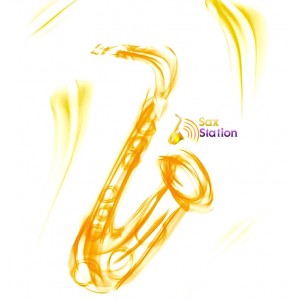
My friend David helped a little with the alignment of the logo Sax Station for this drawing of a dinosaur playing sax.

My friend David helped a little with the alignment of the logo Sax Station for this drawing of a dinosaur playing sax.
I accidentally get overtones and don’t know how to do it purposely.
I’ve been playing a little more or less than a month, and my tonality is better. Overtones are limiting me.
I was curious on how one can achieve overtones purposely? Seems like it gives more range? Or am I mistaken? Appreciate the feedback Neal..
-Edward
My response
Overtones could be a good thing to practice part of the time as you practice. You have only been playing about a month though. I wouldn’t expect to be able to play them perfectly at that point, it will take some practice.
Check out this video I made,
https://saxstation.com/basic-
Ideally you want to play both. You probably should focus more on o ne or the other.
ne or the other.
I mostly play saxophone, I took a year of private piano lessons in college.
When I went to Wooten Woods, Steve Bailey asked me, “how much piano do you play?”
I said, “a little”
He said, “You should play a little more.”
He was right. It’s helpful to know how to play piano regardless of what instrument you play. Really, it’s helpful to know a little about all the instruments so you can understand how they connect in the music. The piano can provide both rhythm and harmony.
Sound
Think about which sound you like. Are you more into classical piano? Do you like Stanley Turrentine playing blues on sax?
The instruments have distinct tones. I would say there is more variety in the tones of different saxophone players since half the instrument is within your own body.
Role in the band
More bands will have piano than have saxophone. Guitar/drums/bass are more common still.
The piano will be playing most of a song either as a lead role or backing or “comping”.
Saxophonists tend to play melodies, “horn lines”, and solo.
Think about what you want to do in the band.
Learning Curve
The saxophone will not sound as good initially playing your first note compared to playing a first note on piano. You also will only need to play one note at a time.
However, transitioning between notes on piano is usually straightforward, going between some notes on saxophone without tonguing can be difficult to make sound good at first.
Both instruments will take a lot of work to master.
Maintenance
Pianos need to be tuned once in a while. You’ll need to tune your saxophone pretty much every time you play (which isn’t difficult, but needs to be done).
You will also need to get new reeds ever few weeks and probably get some minor repairs done about once a year.
By Neal 7 Comments
 Starting on each note
Starting on each note
You can start a major scale on any of the 12 different notes in an octave. Theoretically you can call some of these notes different names, but that doesn’t change what they sound like.
You name a scale based off of the first note.
Here are the twelve notes
C, C#, D, Eb, E, F, F#, G, Ab, A, Bb, B
I used a combination of flats and sharps in the names according to the way I usually think of them.
You can think of scales in terms of solfege, solfa, solfeggio, and the other names for the syllables.
The first note will be do
Do, Re, Mi, Fa, So, La, Ti, Do
For the major scale. That can be a useful system, I used in it in a few classes with singing. But generally I think of the letters in music. You change the syllables a little to raise or lower them by a half step.
Transposing
If you play saxophone, you probably should know about transposing.
Circle of Fifths
A way to practice the twelve major scales would be around the “circle of fifths”
C F Bb Eb Ab C# F# B E A D G
Moving in that direction is similar to the movement of the V chord to the I chord which happens often in music as a resolution.
Four Major Scales
Here are four of the major scales
Saxophone Scales – How to Play C Major Scale on Sax – SaxStation
Saxophone Scales – C# Major Scale – SaxStation
B Major Scale on Saxophone – SaxStation
Saxophone Scales – Ab Major Scale – SaxStation
Same Interval Pattern, Similar Sound
What I would actually recommend is learning the scales initially by reading them, but then trying to really remember and recognize the sound of the major scale. If you do that, you should be able to play a major scale starting on any note.
Basically, the scales become much more useful if you have memorized them.
Order of Flats and Sharps
You will see patterns in the scales as well, especially if you play them in certain orders.
In this order,
C F Bb Eb Ab C# F# B E A D G
You add a flat each time as you progress to the right. After Ab, you go to C# which has 7 sharps and then you begin subtracting one sharp as you go the right.
The flats in a key signature go in a certain order:
Bb, Eb, Ab, Db, Gb, Cb, Fb
The sharps go in the opposite order
F#, C#, G#, D#, A#, E#, B#
If you would like to learn more, check out my Class About Scales
 As I move from say a middle D to a G, I cannot do it legato, I have to tongue it..
As I move from say a middle D to a G, I cannot do it legato, I have to tongue it..
I end up with an overtone that I pull down to the right tone. I’ve spent hours working on getting this interval (not just those two notes middle C to F is often an issue)
-Stefan
My response
I could if you want to sign up for Saxophone Tribe.

Oh and my new sax has a deficiency, the sharp key for G# doesn’t respond quickly, it’s like the seal gets stuck?
-Edward (Bayern)
My response
Your saxophone doesn’t necessarily have a deficiency, having the G# key stick is actually fairly common in a lot of saxophones. Partially due to its position on the horn.
Do you ever eat or drink as you play saxophone?
About the overtones, sometimes they’re caused by your fingers not being at exactly the right time. But also, you will probably learn to avoid those as you keep playing. If you can practice more often, more like everyday, you will improve faster.
My drawing

Saw a playalong app at NAMM 2016 which I liked. Keilwerth is part of the Buffet Group now, so when I went to try out one of the new Keilwerth tenors, I saw an iPad with a microphone set up there.
They have a free app,
iOS: http://itunes.apple.com/us/app/urban-play/id886668420
Android: http://play.google.com/store/apps/details?id=com.buffet_group.UrbanPlay
It requires registration to get all the songs which you download one at a time.
There are four difficulty levels, labeled by numbers.
I liked some of the songs better than others. Overall, it seems like a fun app to play around with.
Check it out if you’re interested!
Drawing Mario, Shigeru Miyamoto’s Super Mario. Playing saxophone of course!

My drawing.



Want to play saxophone, but feeling lost and not sure how to get started?
In this online/downloadable class you will see methodical lessons in a sequence and you can get feedback and ask questions at any point.
Learn more
Want to take your playing to the next level?
You’ll learn fundamental saxophone skills, building past the basics. Master rhythms. Learn about phrasing, tone, and more. Here you will get feedback which is crucial to developing good habits.
Learn more